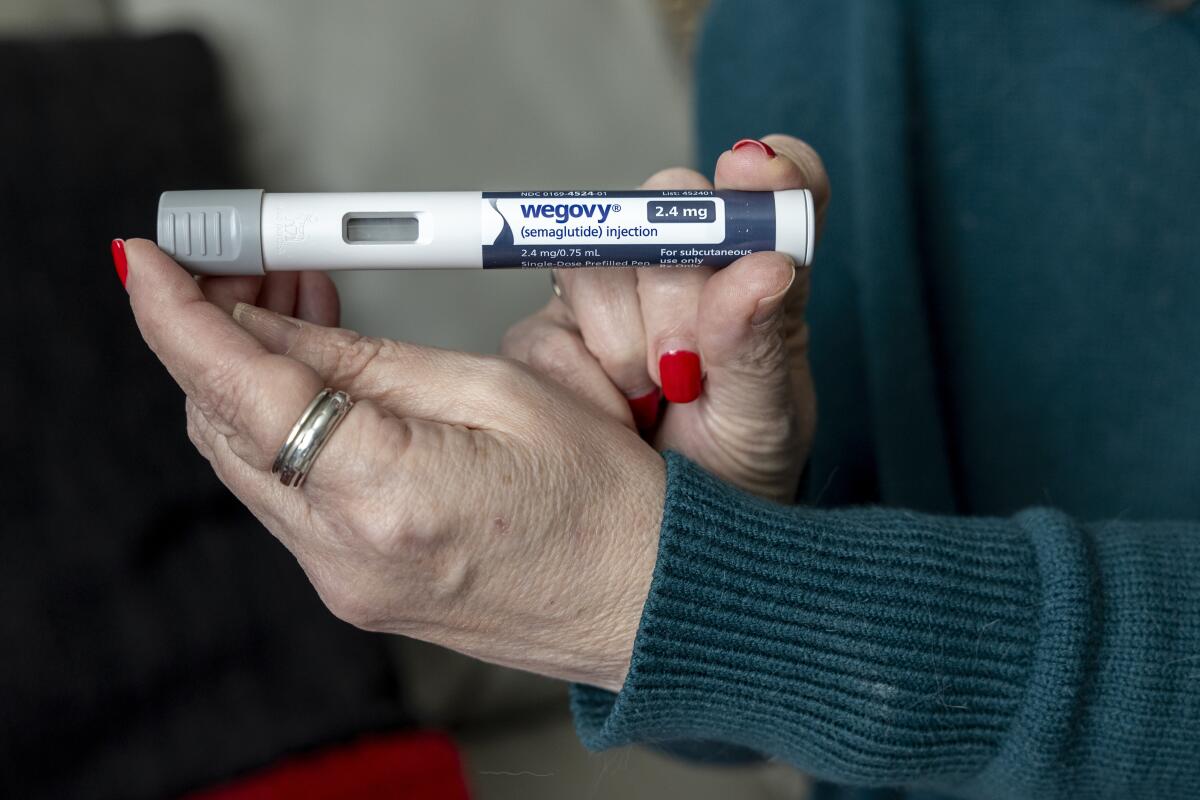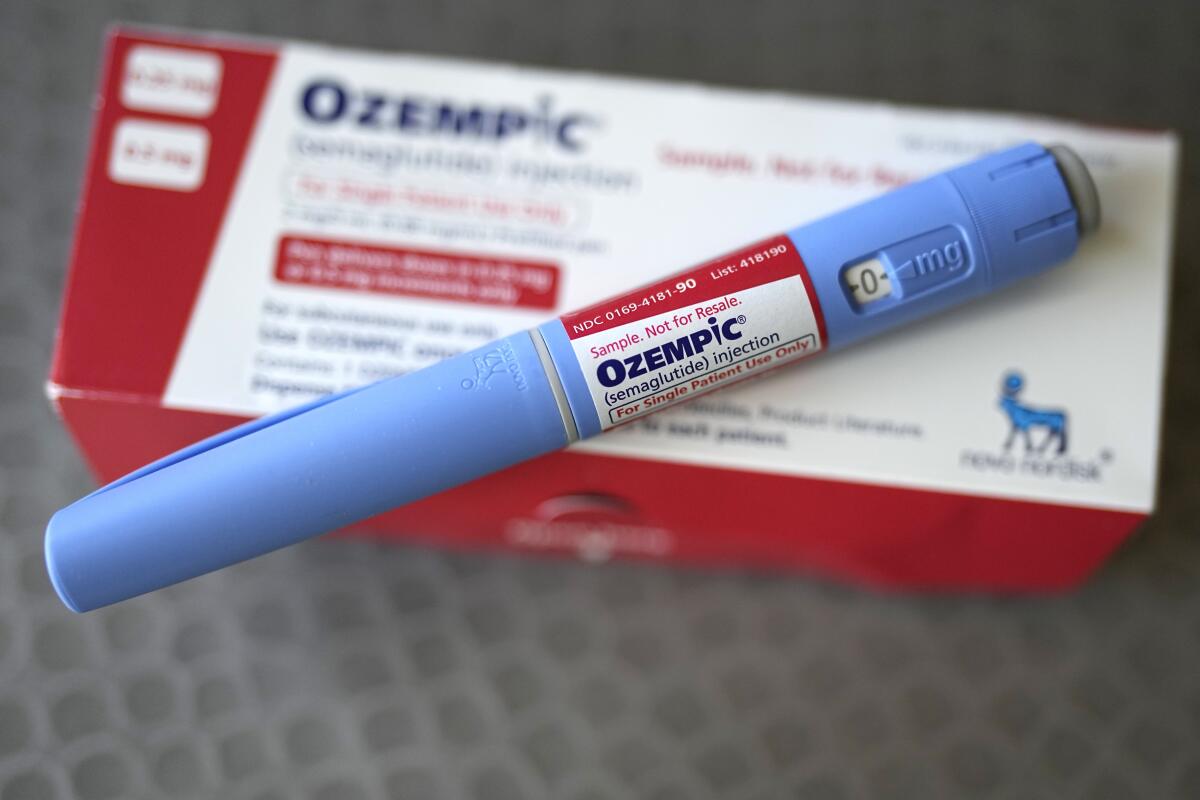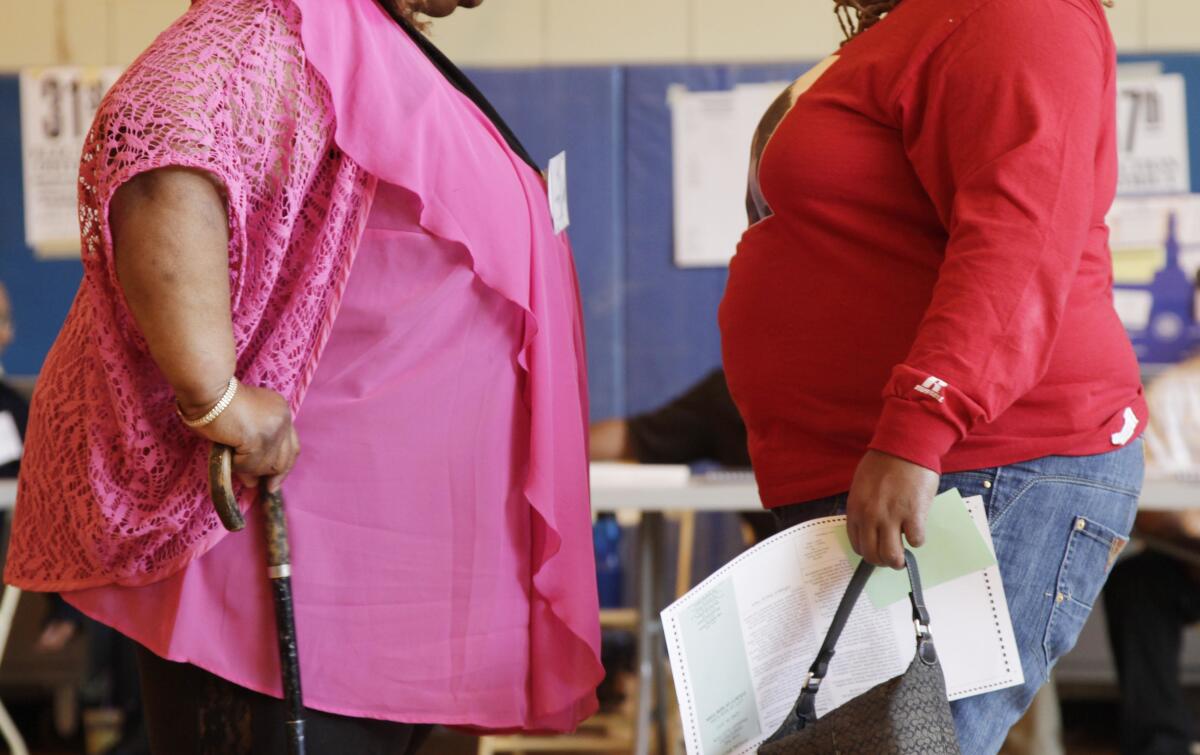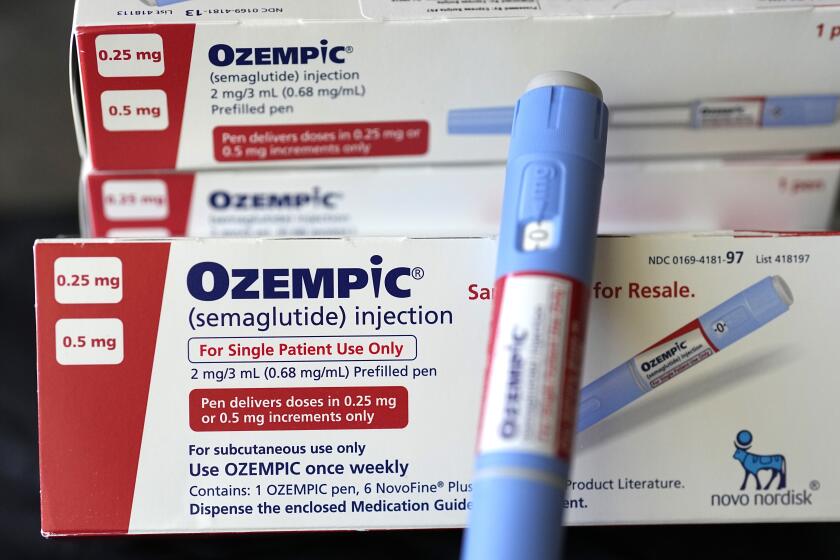‘Miracle’ weight-loss drugs could have reduced health disparities. Instead they got worse

The American Heart Assn. calls them “game changers.”
Oprah Winfrey says they’re “a gift.”
Science magazine anointed them the “2023 Breakthrough of the Year.”
Americans are most familiar with their brand names: Ozempic, Wegovy, Mounjaro, Zepbound. They are the medications that have revolutionized weight loss and raised the possibility of reversing the country’s obesity crisis.
Obesity — like so many diseases — disproportionately affects people in racial and ethnic groups that have been marginalized by the U.S. healthcare system. A class of drugs that succeeds where so many others have failed would seem to be a powerful tool for closing the gap.
Instead, doctors who treat obesity, and the serious health risks that come with it, fear the medications are making this health disparity worse.
“These patients have a higher burden of disease, and they’re less likely to get the medicine that can save their lives,” said Dr. Lauren Eberly, a cardiologist and health services researcher at the University of Pennsylvania. “I feel like if a group of patients has a disproportionate burden, they should have increased access to these medicines.”
Why don’t they? Experts say there are a multitude of reasons, but the primary one is cost.

Ozempic, which is approved by the Food and Drug Administration to help people with Type 2 diabetes control their blood sugar and reduce their risk of serious cardiovascular problems such as heart attacks and strokes, has a list price of $968.52 for a 28-day supply. Wegovy, a higher dose of the same medicine that’s FDA-approved for weight loss in people with obesity or who are overweight and have a weight-related condition such as high blood pressure or high cholesterol, goes for $1,349.02 every four weeks.
Mounjaro is a similar drug approved by the FDA to improve blood sugar levels in Type 2 diabetes patients, and it comes with a list price of $1,069.08 for 28 days of medicine. Zepbound, a version of the same drug approved for weight loss, has a slightly lower price tag of $1,059.87 per 28 days. For now, at least, all the new drugs are meant to be taken indefinitely.
Patients taking Ozempic and other trendy injectables are going under the knife to correct the side effects of rapid weight loss, which include sagging skin, hollow cheeks and an aged appearance.
Few health insurance programs cover the medications when prescribed to help people reach and maintain a healthy weight. Federal law requires that weight loss drugs be excluded from basic coverage in Medicare Part D plans, and as of early 2023, only 10 states included an antiobesity medication in the formularies for their Medicaid programs.
“If everybody had equal access, then this would be a way to help,” said Dr. Rocio Pereira, chief of endocrinology at Denver Health. “But without equal access — which is what we have now — it’s likely this is going to increase the disparity we see.”
U.S. obesity rates have been rising for decades, and they’re consistently higher for Black and Latino Americans. Among adults 20 and older, 49.9% of Black Americans and 45.6% of Hispanic Americans have a body mass index of 30 or greater, compared with 41.1% of white American adults and 16.1% of Asian American adults, according to age-adjusted data from the Centers for Disease Control and Prevention.
Obesity rates are also associated with income. In 2022, the age-adjusted rate was 38.4% for adults with household incomes between $15,000 and $24,999, compared with 34.1% for those with household incomes of $75,000 or more.
The two are related, said Pereira, who studies health disparities in diseases related to obesity. Black and Latino Americans are more likely to live in lower-income neighborhoods, where fast food is usually cheaper and more convenient than grocery stores.
“If you look at a map of the U.S. and plot out the neighborhoods where there’s no grocery store within a mile and there’s a high percentage of people who have no car, those are the areas where there’s the highest rates of obesity,” she said.
There’s also the time factor, she said: “Can you afford to cook your own meals, or do you have to work two jobs?”
An unusual experiment by the Department of Housing and Urban Development demonstrated the degree to which physical surroundings can influence obesity risk, Pereira said. In the 1990s, hundreds of mothers who were living in public housing were offered housing vouchers they could use only in wealthier neighborhoods. Ten to 15 years later, the women randomly assigned to receive the windfall had significantly lower rates of severe obesity (14.4%) than women in a control group who weren’t offered vouchers (17.7%). They were also less likely to have a body mass index of 35 or higher (31.1% vs. 35.5%).

The American Medical Assn. recognized obesity as a disease in 2013. People with the chronic condition are at heightened risk of cardiovascular disease, Type 2 diabetes, 13 types of cancer, osteoarthritis, asthma and other health problems. Researchers have pegged the annual medical costs associated with obesity at $174 billion in the U.S. alone.
Some people with obesity are able to lose weight by changing their diets and burning more calories through exercise. But that doesn’t work for people who have developed resistance to leptin, a hormone that suppresses appetite.
“If you try to lose weight with diet and exercise, your body is going to fight you,” said Dr. Caroline Apovian, co-director of the Center for Weight Management and Wellness at Brigham and Women’s Hospital in Boston. “Your leptin levels go down, and when leptin goes down, a signal goes to the brain that you don’t have enough fat to survive.” That prompts the release of another hormone, ghrelin, that triggers feelings of hunger.
Nearly 3,000 reported overdoses of popular weight loss and diabetes drug semaglutide, sold under the brand names Ozempic and Wegovy, were reported in the United States this year.
Leptin resistance also makes exercise less worthwhile.
“Your body fights you by decreasing your total energy expenditure,” Apovian said. “When your muscles work, they work more efficiently. If you want to lose 10 pounds, you’re going to get really, really hungry. And you can’t fight that. Your body thinks it’s starving to death.”
The “breakthrough” drugs counteract this by impersonating a hormone called glucagon-like peptide 1, or GLP-1, that’s involved in appetite regulation. Inside cells, the drugs bind with the same receptors as GLP-1, reducing blood sugar and slowing digestion. They also last longer than their natural counterparts.

The first so-called GLP-1 receptor agonist was approved in 2005 to treat diabetes, and early versions had to be injected once or twice a day. Ozempic improved on this by requiring an injection only once a week. After clinical trials showed that the drug helped people with obesity achieve substantial, sustainable weight loss, the FDA approved Wegovy as a weight management drug in 2021.
Mounjaro and Zepbound also mimic GLP-1, along with a related hormone called glucose-dependent insulinotropic peptide, or GIP.
The diabetes drug has become the latest weight loss craze, and it triggers bigger concerns over the inherited diet obsession within Latinx culture.
Linda Morales credits Ozempic and Mounjaro for helping her lose 100 pounds and drop from a size 22 to a size 14. The 25-year-old instructional aide at Lankershim Elementary School in North Hollywood said she started to become overweight in middle school and carried 293 pounds on her 5-foot, 5-inch frame when she was referred to the Center for Weight Management and Metabolic Health at Cedars-Sinai two years ago.
She is no longer breathless when she climbs stairs, has an easier time when she goes bowling and fits comfortably into the seat on the Harry Potter ride at Universal Studios. Thanks to the medications, she is no longer on a path toward Type 2 diabetes.
Her job with the Los Angeles Unified School District comes with health insurance that covers the pricey drugs and charges her a copay of $30 a month for her Mounjaro prescription. She said she could swing a monthly payment of up to $50, but beyond that she’d have to stop taking the drug and hope the lifestyle changes she’d made would be enough to sustain the weight loss she’s achieved so far.
“It would definitely get hard for me, for sure,” Morales said.
Indeed, even when the drugs are covered by insurance or patients qualify for discounts from pharmaceutical companies, researchers have found that they often remain out of reach.
In one study, Eberly and her colleagues examined insurance claims for nearly 40,000 people who received a prescription for GLP-1 copycats. Patients who had to pay at least $50 a month to fill their prescriptions were 53% less likely to get most of their refills over the course of a year compared to patients whose copayments were less than $10. Even patients whose out-of-pocket costs were between $10 and $50 were 38% less likely to buy the medicine regularly for a full year, the team found.
In another study of insured patients with Type 2 diabetes, those who were Black were 19% less likely to be treated with these drugs than those who were white, while Latino patients were 9% less likely to get them, Eberly and her colleagues reported.
Less than half of large employers currently cover the new generation of obesity drugs, but an additional 18% say they’re considering adding them amid surging interest.
In some parts of the country, Black patients with diabetes are only half as likely as white patients to get GLP-1 drugs, according to research by Dr. Serena Jingchuan Guo at the University of Florida, who studies health disparities in pharmaceutical access. The disparity was greatest in places with the highest overall usage of the medications, including New York, Silicon Valley and south Florida.
For the record:
9:10 p.m. April 15, 2024An earlier version of this article misspelled the name of Dr. Serena Jingchuan Guo of the University of Florida as Jigchuan.
“In those places, the drug is actually widening the gap,” she said.
Researchers have spent years documenting racial disparities in the use of effective treatments for obesity, such as bariatric surgery. Newer drugs such as Ozempic simply bring the problem into sharper focus, said Dr. Hamlet Gasoyan, an investigator with the Cleveland Clinic’s Center for Value-Based Care Research.
“We get excited every time a new, effective treatment becomes available,” Gasoyan said. “But we should be equally concerned that this new and effective treatment reduces disparities between the haves and have-nots.”











